Menu
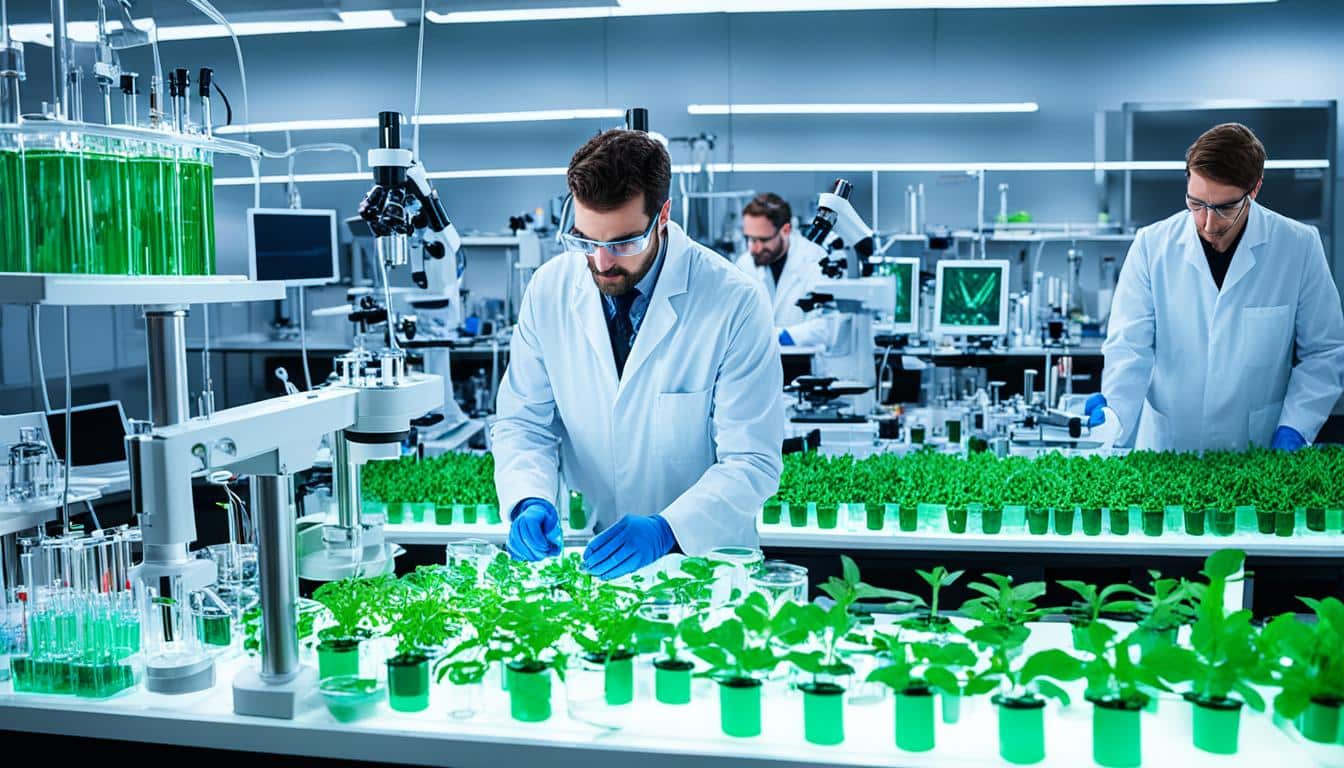
In 1988, a big step was made in biotechnology. This arm of science found ways to add genetic info to plants. It could regrow full plants from just one cell. From here, food production took a giant leap, improving both quality and quantity.
Agrobacterium tumefaciens, a useful bacterium, played a key role. It could put its own DNA into plant cells. This led to genetically modified plants. These plants are stronger against diseases and have better nutrients.
Biotechnology in making food uses many methods. Some include growing crops in labs or tweaking plant DNA for better traits. These innovations are crucial in making our food supply safer and more sustainable. But, we need to talk about how these changes can affect people and the environment.
The field of biotechnology in food has seen big advances in how we grow things. It uses new methods alongside old ones to make plants and animals work better for us. This mix has led to better genetic modification techniques, moving the industry forward.
At the heart of today’s farming tech is genetic modification. This method improves crops, making them stronger and more productive. It lets plants resist weed killers and bugs, cutting down on the need for harmful chemicals.
This technology also helps make crops that pests and weed killers don’t harm. This means our food is better and we get more of it.
By 2012 in the United States, most of the corn, cotton, and soybean crops were genetically modified. Seeing these high numbers shows just how much farmers rely on this tech.
The history of tweaking plants and animals for the best traits goes way back. At first, people chose the best to breed based on what they wanted. But as science and tech got better, we found more accurate ways to do this.
Today, we can put new DNA into plants and make them even better. The use of bacteria like Agrobacterium tumefaciens has been key here. It led to creating plants with extra helpful traits.
Each year, the USDA checks how much of our crops are from biotechnology. This shows how important and common these new methods are in farming.
Combining genetic modification with farming tech leads the way to a more sustainable and productive food future.
Agricultural biotechnology uses new methods to make plants and animals better for farming. It involves both old-fashioned breeding and high-tech genetic engineering. These are key in today’s farming.
For centuries, breeding techniques have let us grow plants and raise animals with the best traits. But, genetic engineering is changing how we do this. Now, we can make crops that can resist herbicides and pests. This means we use fewer chemicals.
In 2012, the USDA found that a lot of corn, cotton, and soybeans in the U.S. were genetically modified. They made up a big part of the crops. So, genetic engineering is a big deal in farming.
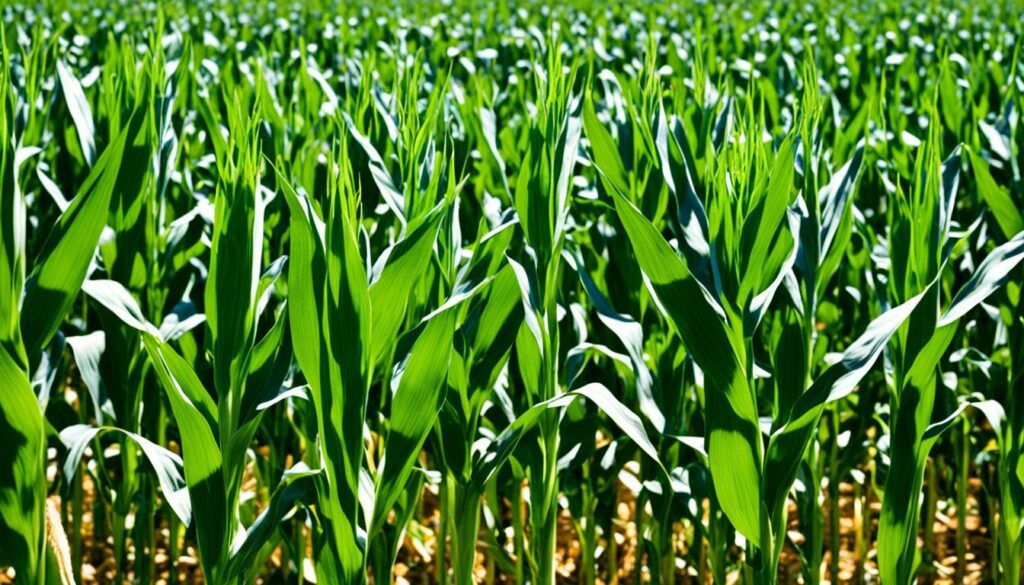
Biotech crops can be more nutritious, survive tough conditions, and even help make medicine. For example, there’s cotton that bugs don’t like, meaning we use less pesticide. And, some crops can handle stronger weed killers. There are also crops that fight off diseases, such as the ones that stop the papaya virus.
People’s safety is very important. The USDA, EPA, and FDA check that genetically modified crops are safe. They look at the environment, how harmful they might be, and if anyone could be allergic. These checks make sure biotech crops are okay for us.
Genetically modified crops aren’t just in the U.S. They’re used worldwide. They help deal with the effects of climate change and make sure there’s enough food everywhere. These crops are a big part of modern farming.
Agricultural biotechnology is creating ways to solve farm problems now and in the future. It’s helping make sure there’s enough food for everyone, in a way that lasts.
Biotechnology in farming has changed how we grow food, bringing many benefits. It helps make more crops and adds better nutrients in our food. This is great news for everyone.
Thanks to biotechnology, farms can grow more food. In the US, most corn, cotton, and soybeans use biotech, reaching 88% to 94% in 2012. This shows many farmers choose biotech to boost their crops’ productivity. For example, in India, special cotton helped farmers increase their yield by 29% and income by 78%. This proves the real help biotechnology brings.
Biotechnology also makes our food more nutritious. For instance, rice with extra beta-carotene helps fight vitamin A lack in poor areas. And, better oils in crops mean healthier cooking oils are possible. By July 2008, more than 20 nutritious food biotech items were available, showing biotechnology’s growing power for good.
People like what biotechnology does for food. About 78% prefer these foods for their health benefits. This includes better fats and less harmful fats. These numbers show how biotechnology not only helps farmers but also meets what people want in healthier foods.
Bioengineering in agriculture is mainly driven by recombinant DNA technology. This tech allows scientists to make precise changes to plant genes. It’s changed how we improve crop features and deal with farming issues.
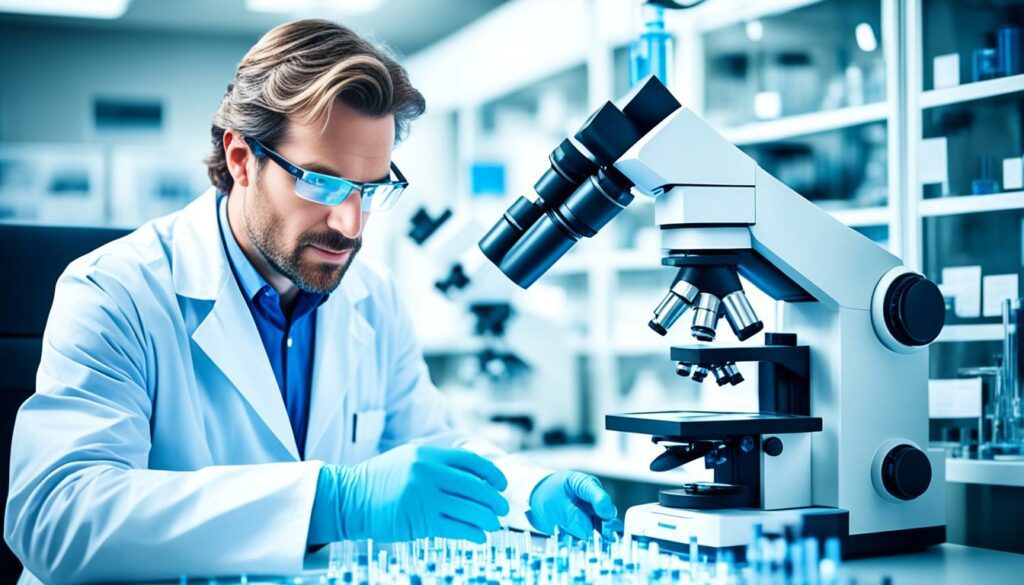
Recombinant DNA technology puts new genetic material into a plant’s DNA. This has led to big advances in changing plants. The use of Agrobacterium tumefaciens is one way. It’s a bacterium that can add DNA to plant cells. A key thing it does is add genes that make plants resistant to drugs like kanamycin. This makes it easier to spot which plants have been changed.
Plant cell and tissue culture has improved a lot recently. It can grow whole plants from just a few cells. This is possible thanks to better techniques in growing plant tissues. One important step involves working with plant cells that have no walls. They are called protoplasts. With the help of Agrobacterium, it’s easier to transfer new genes into these plant cells.
| Advances in Plant Bioengineering | Impact |
|---|---|
| Protoplast Utilisation | Made direct transfer of new genes possible. |
| Leaf Disk Modification | Caused plants to grow back in 3-4 weeks. |
| Kanamycin Resistance | Made it easy to see which plants were modified. |
Bioengineering has given us new insights into plants. It helps us understand how genes work, how proteins move, and how they are made in plants.
“The versatility and efficacy of Agrobacterium tumefaciens in gene expression studies highlight its indispensable role in plant bioengineering.”
Biotechnology is key for sustainable farming, using nature wisely. It focuses on biotech advances to boost our food supply.
It’s shown in the U.S., where many crops like corn, cotton, and soy use biotech. About 88%, 94%, and 93% were grown this way in 2012. This shows how much biotechnology matters in farming today.
Genetic engineering makes crops stronger against bugs and diseases. This boosts harvests and quality. Crops like canola and soy now have better oils, thanks to food technology. All this helps keep farming safe for the planet.
Across the world, biotech crops are big news. The International Service for the Acquisition of Agri-biotech Applications (ISAAA) shares that fact. With our population expected to hit 9 billion by 2030, biotech is crucial for our food and the earth’s health.
By joining food growing with caring for nature, we can feed everyone and preserve the planet. This mix brings good farming practices, making money, and fairness. Adding biotechnology helps improve soil, nutrients, and farm life.
| Crop | Biotech Plantings (2012) |
|---|---|
| Corn | 88% |
| Cotton | 94% |
| Soybeans | 93% |
Biotech also aids in easier and better weed control. But it faces some tough challenges. These include what people think, GMO (genetically modified organism) risks, and saving wildlife.
Sustainable farming pulls together many fields, like biology and economics. With the help of biotech, it aims to grow more food without hurting our planet.
Applications of biotechnology are changing how we farm animals. This technology helps us produce vaccines for deadly diseases like foot and mouth and rabies. It means we have healthier animals. The use of biotech methods has made great strides in animal farming.
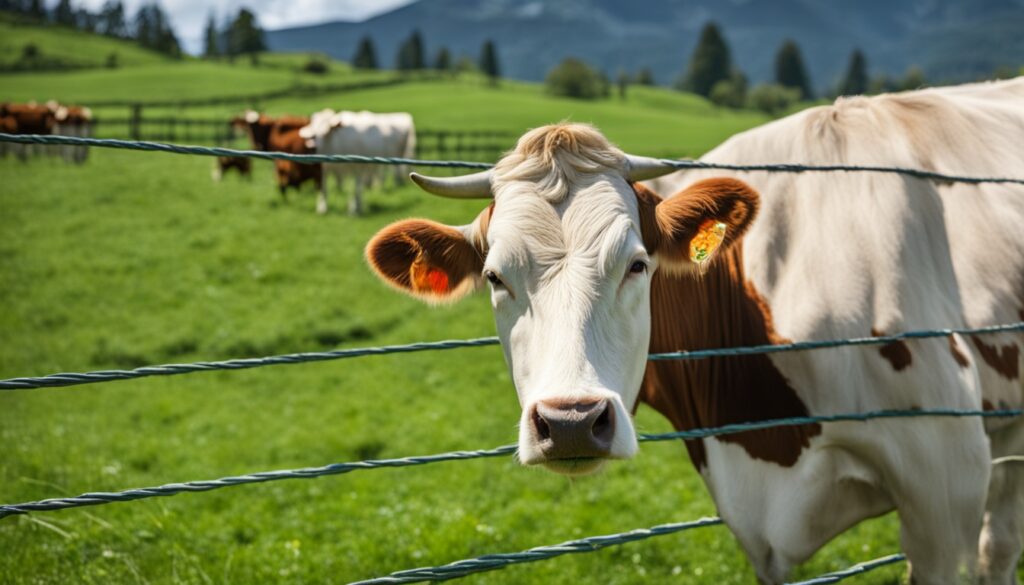
One key benefit is better antibiotic production thanks to biotechnology. This has made fighting diseases in animals more effective. Livestock is now better protected against diseases.
Here are some key facts about the use of biotechnology:
| Year | Biotechnology Plantings in the U.S. |
|---|---|
| 2012 | Corn: 88%, Cotton: 94%, Soybeans: 93% |
| 2012 | Global area of biotech crops estimated by ISAAA |
Also, the U.S. enzyme market in farming animals is very important economically. The use of biotech crops in the U.S. is growing fast, according to the USDA. For example, in 1985, enzyme sales reached $185 million, mostly in food processing. Enzymes like α-amylase and glucose isomerase are crucial in making cornstarch. They make up 85% of enzyme sales for food.
Genetic engineering is also used. It uses Bacillus subtilis to make α-amylase. The goal is to create heat-resistant enzymes. This leads to making things cheaper, like HFCS (high-fructose corn syrup). Its use grew from 2.3 kg to 20 kg per person between 1975 and 1985.
To sum up, biotechnology is making a big difference in animal farming. It uses genetic engineering and microbial fermentation to boost productivity and animal health. These advances help create a better farming future, with healthier animals and a stronger agriculture industry.
Biotechnology in farming has changed how we deal with pests. It has led to making pest-resistant crops. This means we use fewer harmful chemicals in farming.
Biotechnology’s big win is crops that can fight pests and diseases better. In 2012, most plants in the US were biotech. These crops help against bugs and diseases, giving us more and safer food.
USDA’s NASS follows how well these crops do, showing they are widely used and make a big difference.
Biotechnology means we don’t need as many synthetic pesticides. Cotton that can fight bugs itself is one example. Plants like soybeans and maize can survive weed killers. These weed killers are safe for people and wildlife, helping the environment.
Biotech crops also make farming easier and safer for growers. They can help us get more crops with less work. By tackling pests and diseases, biotechnology pushes for greener and smarter farming.
The debate around genetically modified organisms (GMOs) in food is active and controversial. Scientists agree that GMOs are not more harmful than regular foods to our health. Yet, many people still have mixed feelings about them.
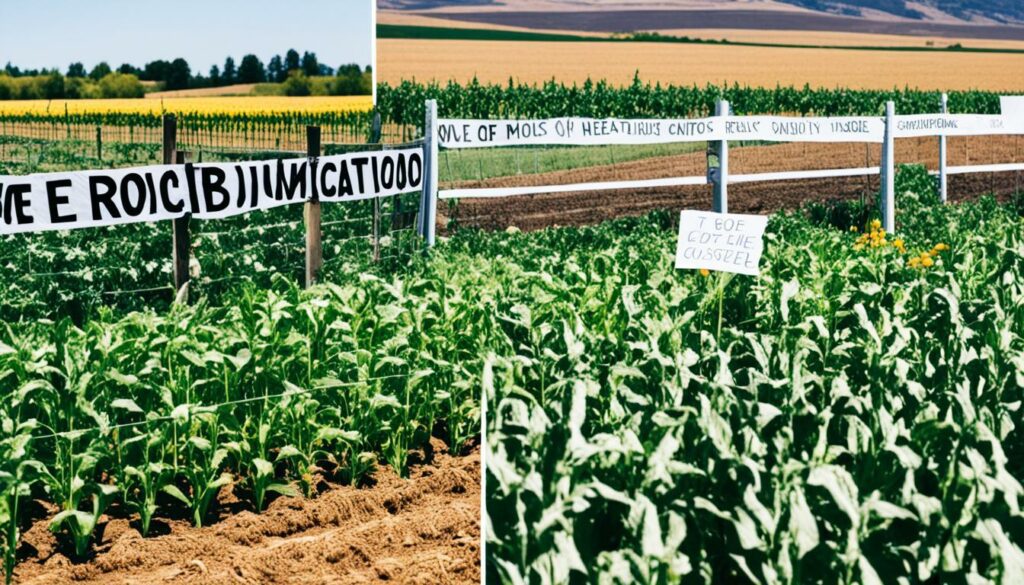
GMO views vary across the world. In the U.S., for example, a 2010 Deloitte survey showed concerns, but these were decreasing. In comparison, most Europeans are not concerned about GMOs unless the issue is clearly highlighted, seen in a 2010 Eurobarometer survey.
Despite clear scientific findings, confusion and wrong beliefs about GMOs continue. An example is a 2013 New York Times poll where 93% of Americans wanted GMO foods labelled. This shows a strong desire for more information on where our food comes from.
The safety of GMO products is ensured by strict guidelines. In the EU, if a food has more than 0.9% GMOs, it has to be clearly marked. This rule aims to inform consumers. Similarly, in the United States, after January 2022, foods with GMOs must be labelled as “bioengineered food.”
These rules come from extensive scientific reviews. Verma et al. (2011) confirmed that GMO foods are as safe as non-GMO foods for us. Furthermore, the use of biotechnologies, such as glyphosate-resistant crops, is regularly checked for its impact on our environment. This is to make sure we are safe and our ecosystem is balanced.
However, facts often get overshadowed by myths:
| Survey/Study | Data/Findings |
|---|---|
| Deloitte Survey (2010) | 34% of U.S. consumers very or extremely concerned about GM food, down by 3% from 2008 |
| Eurobarometer Survey (2010) | Most Europeans do not care about GMOs unless explicitly presented |
| New York Times Poll (2013) | 93% of Americans wanted labeling of GM food |
| Verma et al. (2011) | No documented ill effects from genetically modified food on human health |
By understanding both sides of the GMO debate and the rules in place, we can grasp the full picture. This helps us see how GMO technologies fit into our modern food making.
Food biotechnology is changing, thanks to exciting technologies such as genome editing and synthetic biology. These are promising to improve the way we eat. They focus on making food healthier and changing how we make it.
CRISPR-Cas9 gives us a precise way to change genes. It’s helping to make crops tough against things like drought and bugs. This tech can also add more vitamins and minerals to crops. This is important because it fights global hunger by making food more nutritious. For example, scientists are designing rice that’s full of nutrients, which is a big help in fighting malnutrition.
Synthetic biology is a step ahead, letting us make organisms with custom jobs. It’s used to create future foods that are good for us and the planet. Think about lab-grown meat and dairy. They taste like the real thing but are better for the environment. This field also brings new tastes and textures to food, making meals more exciting.
Back in 1985, enzymes were big business in the U.S., making $185 million in food processing. They were mainly used for breaking down proteins and starches. Companies were already using genetically modified enzymes. This was a big step in the use of biotechnology in making food.
| Year | Enzyme Sales (Million USD) | Share in Food Industry (%) |
|---|---|---|
| 1985 | 185 | 58 |
| 1985 | Proteinase & Carbohydrase | 85 |
CRISPR-Cas9 and synthetic biology are leading the way in making food better. By embracing these technologies, we’re moving towards a safer, healthier, and more sustainable food future. It’s a big change for the way we make and enjoy food.
Biotechnology has changed modern farming, leading to better crop growth and helping the environment. These crops play a key role in saving the environment beyond just helping us grow more food. They help clean the soil and protect natural resources.
Phytoremediation uses plants to clean soil from harmful substances. This is done by special biotech crops. They take in pollutants, which not only makes the environment cleaner but also improves the soil quality. This means the land can be used to grow food again.
Around 2012, most corn, cotton, and soybeans in the United States were biotechnology plants. Their special qualities lower the need for pesticides and herbicides, which helps the environment a lot. For example, the use of such plants reduced the amount of pesticide used by 671.4 million kg. Plus, it cut down the harm these chemicals do by 18.4%.
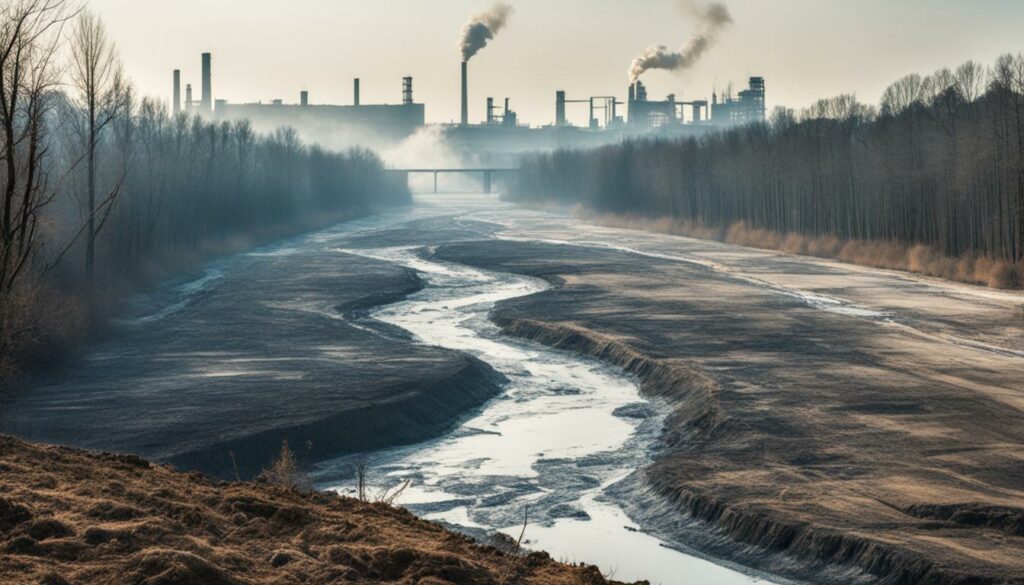
Biotech crops offer more than just cleaning soil. They reduce the use of harmful chemicals and the need for constant ploughing. This helps save water, stop soil erosion, and keep nature diverse. Their use also cuts down on greenhouse gas emissions. In 2016, it was like taking 16.7 million cars off the road.
By 2016, nearly half of the crops worldwide were biotech. These included canola, maize, cotton, and soybean. Their special design helps farmers make better use of land and resources.
Even though the use of some herbicides in GM crops has slightly gone up, their effect on the environment has gotten better. For example, from 1996 to 2016, the use of a key herbicide in GM soybeans increased by 0.4%. But, because they used more eco-friendly herbicides, the environment benefited 13.4% more.
| Biotech Crop | Percentage of Total Plantings (2012) | Reduction in Pesticide Spraying (kg) | Decrease in EIQ | Greenhouse Gas Emissions Reduction (2016) |
|---|---|---|---|---|
| Corn | 88% | 671.4 million kg | 18.4% | Equivalent to removing 16.7 million cars |
| Cotton | 94% | |||
| Soybeans | 93% | |||
| Global Biotech Crops (2016) | 48% | n/a | ||
Biotechnology in farming is crucial for protecting our environment. Its use of phytoremediation and the lessening of resource reliance are big steps towards a greener future. These crops are a key part of making agriculture sustainable.
The food biotechnology market is growing fast. This growth comes from the need for eco-friendly food methods and more people to feed. Different areas are boosting their farming tech to keep up. It’s important to watch this market closely, including its key players and new ideas.
The market for food biotechnology is looking at a leap of 10.1% yearly by 2029. The push for better farming that doesn’t harm the Earth is driving this. Right now, North America is leading in food biotech, with over USD 800 million invested. Exact market size numbers differ but are all in the billions.
From 2024 to 2032, the market will grow even more. Europe is big in health foods and supplements, with a growth rate of 11%. In places like Brazil too, their huge farming output is opening up more market chances.
Companies like ABS Global, BASF Plant Science, and Syngenta AG are key in food tech. They use new tech like DNA mixing and special crops to grow more and fight pests better. Others making a mark include AquaBounty Technologies, Bayer CropScience AG, and Arcadia Biosciences.
Important trends in the market include making GMOs to improve food safety worldwide. New farming methods, along with CRISPR-Cas9 tech, promise to make even better crops. These could have awesome features.
The market is also seeing more interest in making food from microbes and plant-based options. Blockchain is stepping in, making the food chain easier to understand and trust. This is part of the move towards greener and safer food production.
| Region | Market Share (%) | Key Characteristics |
|---|---|---|
| North America | Largest Market | High research funding, robust biotech initiatives |
| Europe | Fastest Growing Market | Strong interest in functional foods, nutraceuticals |
| Latin America | Growing Opportunities | Significant agricultural output, especially Brazil |
The food biotechnology market is full of new and exciting things. Key players and future trends show we’re in for big growth. Technology and a focus on being eco-friendly in food making are driving this.
Looking at biotechnology in farming highlights its success through examples like Bt cotton and Golden Rice. These show how genetic engineering can make big changes. Particularly, Bt cotton in India and Golden Rice show the big potential of biotech solutions worldwide.
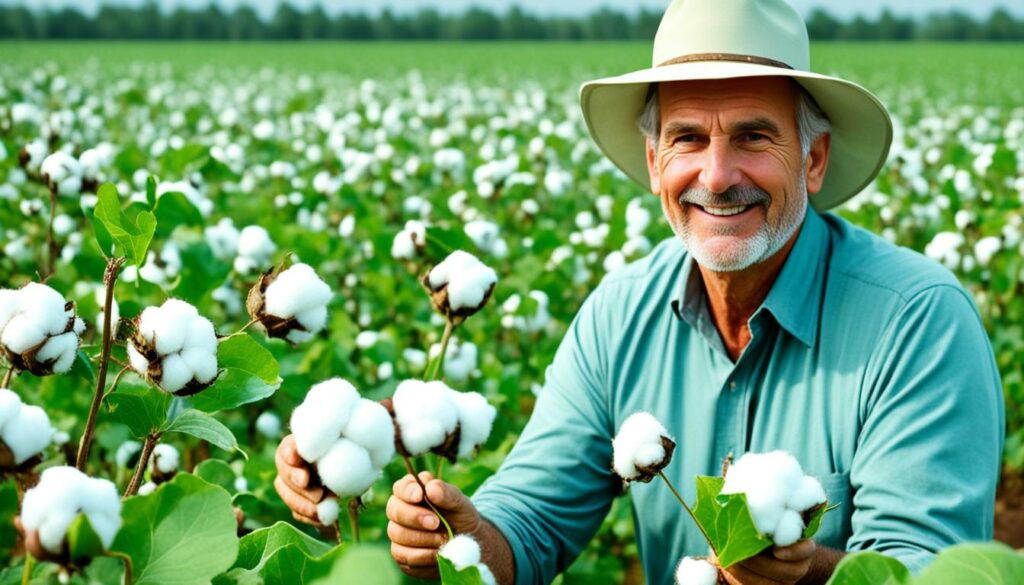
Bt cotton’s launch in India marked a key point in biotech crops. It fights pests naturally, needing fewer toxic sprays. This led to less crop loss to pests and more productivity for farmers. From 2002 to 2014, its use increased a lot. This helped make India one of the top cotton producers in the world.
Golden Rice is a top example in biotech crops that aims to improve nutrition worldwide. It has more beta-carotene, which turns into vitamin A in our bodies. This rice fights off a serious health issue in poor countries – lack of vitamin A. This lack can even cause blindness and death. Golden Rice shows how GMOs in key foods can better health outcomes.
| Case Study | Key Impact | Regional Importance |
|---|---|---|
| Bt Cotton | Pest Resistance, Increased Yield | India |
| Golden Rice | Enhanced Nutrition, Vitamin A | Developing Countries |
Both Bt cotton and Golden Rice show the big benefits of biotech crops. They are tackling farming and nutrition problems worldwide. These big examples prove that biotechnology boosts farming efficiency. Plus, it’s key in solving major health issues among the public.
Biotechnology in food production is very promising for the future. Researchers are working hard to make it better. They can now put new genetic information into plant’s cells easier. This allows for big improvements in food making.
Scientists are focusing on making plants better at using and growing light. They have added new genes from other organisms into plant cells. This shows how useful the current techniques are for many types of studies.
These methods help us learn more about how genes and proteins work in plants. And this has been a big step forward in the last few years.
Soon, we’ll need better ways to produce food, as there will be nearly 10 billion people to feed. Biotechnological advancements aim to meet this demand. For instance, researchers have put genes from beans into flowers. This makes proteins only where they are needed, potentially increasing food production and quality.
Also, new ways of making food using enzymes are getting better. Scientists use computer models to change enzymes to work perfectly for food production.
Using both old and new methods in making food is key. But there are challenges to face, like making sure people trust the food is safe. Working together with experts is crucial. They help us use biotechnology safely and effectively in growing food.
Biotechnology in food production uses living organisms to improve agricultural items. It involves methods like modifying genes, fermenting with microbes, and creating biotech crops. These methods help to boost both the quality and quantity of food.
Genetic modification tweaks an organism’s DNA to show specific traits. For example, it can make crops tolerate herbicides, resist pests, and be more nutritious. This process is important in agricultural technology by making crops tougher and less in need of pesticides.
Agricultural biotechnology has a long history, dating back centuries. It began with simple breeding and has progressed to complex genetic engineering. These advances have brought huge changes to farming with improved plant and animal agriculture.
Agricultural biotechnology employs both old and new methods. This includes techniques such as changing an organism’s DNA and growing crops from single cells. These methods help to develop strong, nutrient-packed plants.
Biotech crops have their genes modified to grow in difficult conditions. They show traits such as fighting off pests and diseases. These crops are made to increase food supply and secure food for the future.
There are many upsides to using biotechnology in farming. It can boost crop amounts and improve their quality. It can also make food more nutritious and cut down the need for harmful pesticides. All these actions contribute to making sure we have enough food sustainably.
Bioengineering in farming involves putting specific genetic data into plants. This is done using advanced DNA techniques. Being able to regrow plants from single cells is a key part of agricultural progress.
Recombinant DNA helps insert and change genetic materials in organisms. It’s essential for making plants and animals better suited for our needs. This means we can grow crops that can resist pests or diseases, for example.
Biotechnology makes farming more efficient and less reliant on harmful chemicals. It also helps crops deal with tough conditions. These efforts are about making sure farming lasts without hurting the planet.
In animal farming, biotechnology is used to make antibiotics, develop disease vaccines, and improve animal health. It’s also about boosting how much food animals can produce.
Biotechnology can make crops naturally better at fighting off pests and diseases. This means farming can be simpler and less damaging to the environment.
Many people worry about GMOs. They’re concerned about the safety of these foods. But, governments make sure that GMOs are safe and won’t harm us or the environment.
CRISPR-Cas9 and synthetic biology are changing the game for food technology. These advances could mean foods that are healthier and taste better.
Biotech crops can help clean up soil and water by absorbing toxins. They also use fewer natural resources, which is good for the planet.
The market for food technology is getting bigger as more people want food that’s good for the earth. New ideas about food’s resilience and nutrition are really moving the industry forward.
Bt cotton and Golden Rice are stand out examples. Bt cotton has really helped protect crops and increase yields. Golden Rice helps fight vitamin A deficiency by adding beta-carotene to the grain.
Researchers are aiming for plants that can grow even in bad soils or severe weather. These new ways could change how we farm all over the world, making sure we can all get enough to eat.